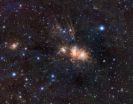(Press-News.org) An active stellar nursery lies hidden inside a massive dark cloud rich in molecules and dust in the constellation of Monoceros. Although it appears close in the sky to the more familiar Orion Nebula it is actually almost twice as far from Earth, at a distance of about 2700 light-years. In visible light a grouping of massive hot stars creates a beautiful collection of reflection nebulae where the bluish starlight is scattered from parts of the dark, foggy outer layers of the molecular cloud. However, most of the new-born massive stars remain hidden as the thick interstellar dust strongly absorbs their ultraviolet and visible light.
In this gorgeous infrared image taken from ESO's Paranal Observatory in northern Chile, the Visible and Infrared Survey Telescope for Astronomy (VISTA [1], eso0949 - http://www.eso.org/public/news/eso0949/) penetrates the dark curtain of cosmic dust and reveals in astonishing detail the folds, loops and filaments sculpted from the dusty interstellar matter by intense particle winds and the radiation emitted by hot young stars.
"When I first saw this image I just said 'Wow!' I was amazed to see all the dust streamers so clearly around the Monoceros R2 cluster, as well as the jets from highly embedded young stellar objects. There is such a great wealth of exciting detail revealed in these VISTA images," says Jim Emerson, of Queen Mary, University of London and leader of the VISTA consortium.
With its huge field of view, large mirror and sensitive camera, VISTA is ideal for obtaining deep, high quality infrared images of large areas of the sky, such as the Monoceros R2 region. The width of VISTA's field of view is equivalent to about 80 light-years at this distance. Since the dust is largely transparent at infrared wavelengths, many young stars that cannot be seen in visible-light images become apparent. The most massive of these stars are less than ten million years old.
The new image was created from exposures taken in three different parts of the near-infrared spectrum. In molecular clouds like Monoceros R2, the low temperatures and relatively high densities allow molecules to form, such as hydrogen, which under certain conditions emit strongly in the near infrared. Many of the pink and red structures that appear in the VISTA image are probably the glows from molecular hydrogen in outflows from young stars.
Monoceros R2 has a dense core, no more than two light-years in extent, which is packed with very massive young stars, as well as a cluster of bright infrared sources, which are typically new-born massive stars still surrounded by dusty discs. This region lies at the centre of the image, where a much higher concentration of stars is visible on close inspection and where the prominent reddish features probably indicate emission from molecular hydrogen.
The rightmost of the bright clouds in the centre of the picture is NGC 2170, the brightest reflection nebula in this region. In visible light, the nebulae appear as bright, light blue islands in a dark ocean, while in the infrared frenetic factories are revealed in their interiors where hundreds of massive stars are coming into existence. NGC 2170 is faintly visible through a small telescope and was discovered by William Herschel from England in 1784.
Stars form in a process that typically lasts few million years and which takes place inside large clouds of interstellar gas and dust, hundreds of light-years across. Because the interstellar dust is opaque to visible light, infrared and radio observations are crucial in the understanding of the earliest stages of the stellar evolution. By mapping the southern sky systematically, VISTA will gather some 300 gigabytes per night, providing a huge amount of information on those regions that will be studied in greater detail by the Very Large Telescope (VLT), the Atacama Large Millimeter/submillimeter Array (ALMA) and, in the future, by the European Extremely Large Telescope (E-ELT).
INFORMATION:
Notes
[1] With its 4.1-metre primary mirror, VISTA is the largest survey telescope in the world and is equipped with the largest infrared camera on any telescope, with 67 million pixels. It is dedicated to sky surveys, which began early in 2010. Located on a peak next to Cerro Paranal, the home of the ESO VLT in northern Chile, VISTA shares the same exceptional observing conditions. Due to the remarkable quality of the sky in this area of the Atacama Desert, one of the driest sites on Earth, Cerro Armazones, located only 20 km away from Cerro Paranal, has been recently selected as the site for the future E-ELT.
More information
ESO, the European Southern Observatory, is the foremost intergovernmental astronomy organisation in Europe and the world's most productive astronomical observatory. It is supported by 14 countries: Austria, Belgium, the Czech Republic, Denmark, France, Finland, Germany, Italy, the Netherlands, Portugal, Spain, Sweden, Switzerland and the United Kingdom. ESO carries out an ambitious programme focused on the design, construction and operation of powerful ground-based observing facilities enabling astronomers to make important scientific discoveries. ESO also plays a leading role in promoting and organising cooperation in astronomical research. ESO operates three unique world-class observing sites in Chile: La Silla, Paranal and Chajnantor. At Paranal, ESO operates the Very Large Telescope, the world's most advanced visible-light astronomical observatory and VISTA, the world's largest survey telescope. ESO is the European partner of a revolutionary astronomical telescope ALMA, the largest astronomical project in existence. ESO is currently planning a 42-metre European Extremely Large optical/near-infrared Telescope, the E-ELT, which will become "the world's biggest eye on the sky".
Links
The VISTA telescope: http://www.eso.org/public/teles-instr/surveytelescopes/vista.html
Contacts
Richard Hook
ESO, Paranal, La Silla, E-ELT and Survey Telescopes Public Information Officer
Garching bei München, Germany
Tel: +49 89 3200 6655
Email: rhook@eso.org
VISTA reveals the secret of the unicorn
2010-10-07
ELSE PRESS RELEASES FROM THIS DATE:
Nano drugs
2010-10-07
Researchers in India have demonstrated that producing nanoscopic crystals of a pharmaceutical product can allow the medication to be absorbed by the gut even if the drug is not soluble in water.
Research suggests that more than half of the medicinal drugs being developed by the pharmaceutical industry dissolve only very weakly in water, if at all. This is a major problem for administering such drugs as it means they are not effective if taken by mouth. The industry has developed many approaches to addressing this problem, such as adding a small quantity of an organic ...
Study sheds new light on how the sun affects the Earth's climate
2010-10-07
The Sun's activity has recently affected the Earth's atmosphere and climate in unexpected ways, according to a new study published today in the journal Nature. The study, by researchers from Imperial College London and the University of Colorado, shows that a decline in the Sun's activity does not always mean that the Earth becomes cooler.
It is well established that the Sun's activity waxes and wanes over an 11-year cycle and that as its activity wanes, the overall amount of radiation reaching the Earth decreases. Today's study looked at the Sun's activity over the period ...
Provocative new Montreal study probes link between breast cancer and air pollution
2010-10-07
Air pollution has already been linked to a range of health problems. Now, a ground-breaking new study suggests pollution from traffic may put women at risk for another deadly disease. The study, published in the prestigious journal Environmental Health Perspectives, by researchers from The Research Institute of the MUHC (RI MUHC; Dr. Mark Goldberg), McGill University (Drs. Goldberg, Dan Crouse and Nancy Ross), and Université de Montréal (Dr. France Labrèche), links the risk of breast cancer – the second leading cause of death from cancer in women – to traffic-related air ...
VTT printed hemoglobin test on paper
2010-10-07
VTT printed the paper with antibodies that react to the sample. The test result can be read in the form of a line, for example, which either does or does not appear depending on the sample – just like in the pregnancy tests already familiar to consumers. It is also possible to print instructional images or text, for example, either on or alongside the test.
Printed paper test can be used to test quickly and easily for the presence of a given substance. The test can be adapted to different purposes by exchanging the identifying antibody printed on the paper for another, ...
First clinical trial of gene therapy for muscular dystrophy lends insight into the disease
2010-10-07
CHAPEL HILL – A clinical trial designed to replace the genetic defect causing the most common form of muscular dystrophy has uncovered an unexpected aspect of the disease. The trial, based on therapy designed by scientists at the University of North Carolina at Chapel Hill School of Medicine, showed that some patients mount an immune response to the dystrophin protein even before they have received the gene therapy.
The puzzling results, which came from trials at Columbus Children's Hospital in Ohio, suggest that the immune systems of a number of patients -- once thought ...
BLADE software eliminates 'drive-by downloads' from malicious websites
2010-10-07
Insecure Web browsers and the growing number of complex applets and browser plug-in applications are allowing malicious software to spread faster than ever on the Internet. Some websites are installing malicious code, such as spyware, on computers without the user's knowledge or consent.
These so-called "drive-by downloads" signal a shift away from using spam and malicious e-mail attachments to infect computers. Approximately 560,000 websites -- and 5.5 million Web pages on those sites -- were infected with malware during the fourth quarter of 2009.
A new tool that ...
Psychologist finds 'shocking' impact on name recall
2010-10-07
It's an experience shared by everyone: You run into someone you know, but his or her name escapes you.
Now, Temple psychologist Ingrid Olson has found a way to improve the recall of proper names.
Olson dedicates her research to understanding human memory. In a recent study, she found that electric stimulation of the right anterior temporal lobe of the brain improved the recall of proper names in young adults by 11 percent. Her study appears this month in the journal Neuropsychologia.
"We know a lot about how to make people's memory worse, but we don't know very ...
New fish feeds made from fish byproducts
2010-10-07
Fish byproducts may be a new source of fish feed, thanks to research by U.S. Department of Agriculture (USDA)-funded scientists in Hawaii.
Research scientist Dong-Fang Deng and her colleagues with the Oceanic Institute in Waimanalo, Hawaii, are collaborating with USDA food technologist Peter Bechtel to develop the new fish feeds. Bechtel is with the USDA Agricultural Research Service (ARS) Subarctic Agricultural Research Unit in Kodiak, Alaska. ARS is the USDA's principal intramural scientific research agency.
The scientists are taking fish parts that would normally ...
One lock, many keys
2010-10-07
In order to track down pathogens and render them harmless, the immune system must be able to recognize myriad different foreign substances and react to them. Scientists at the Max Planck Institute of Immunobiology and the Centre for Biological Signalling Studies BIOSS at the University of Freiburg have discovered how the immune system's B-cells can be activated by numerous substances from our environment. The receptor molecules on the surface of the B-cells are only activated when the receptor subunits separate following the binding of foreign substances. These findings ...
$5 million NSF grant will upgrade and expand NJIT radio telescope array
2010-10-07
A $5 million National Science Foundation (NSF) grant to upgrade and expand a set of radio frequency antennas at Owens Valley Solar Array (OVSA) http://www.ovsa.njit.edu/ has been awarded to NJIT. The new facility is expected to help scientists better understand the nature of solar flares which greatly interest government, industry and the military.
"Space weather incidents such as coronal mass ejections and solar flares can cause problems with cell phone reception, GPS systems, power grids and other technologies," said NJIT Distinguished Professor Dale Gary, a world-renowned ...



